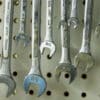A chainsaw is an essential tool that should be taken care of. Often people find it a tough and intimidating tool. Some doubt if it can be sharpened at home. The fact is, maintaining the equipment is a straight forward task. If you use a dull saw, you are likely to consume a lot of fuel. This is uneconomical. Moreover, the saw will struggle to cut the wood; as a result, it will wearing out. In worse cases, it can lead to accidents. You do not have to mess up with your chain saw. Instead, follow the following guide on how to sharpen a chainsaw and learn how to do it quickly and efficiently in the comfort of your home.
What to do before embarking on the sharpening process
In order to make up your mind that the saw requires sharpening maintenance, you should inspect it first. This will help you know if the chain is broken or just dull. After confirmation, you should do the following.
- Identify the type of your chainsaw and the recommended sharpening angle. The information is present in the tool’s manual. You can also get the information by looking at the chainsaw identification code that is usually indicated on the driving link.
- Dress up with protective gear that includes eyewear and gloves. This will lower the chances of accidents during the sharpening process.
- If you make up your mind to sharpen the chain when it is still attached to the chain saw bar, ensure it is appropriately tensioned.
- Turn off your saw before you start performing the maintenance.
- Wipe any oil or grease present on the chain. This is important because it will prevent build-up occurring on the wheel or file teeth during the grinding process.
- Inspect the damage present on your saw. If you discover that the chain is broken, repair or replace it first.
- Finally, check and adjust the depth gauges and start the chain saw sharpening process.
Steps to follow to sharpen a chainsaw correctly.
- Start by cleaning the chain. This will aid in the prevention of unnecessary accidents.
- Secondly, ensure your saw is steady. More importantly, make sure the clamp is tight enough; hence the saw cannot move by itself. Look out for the cutter since they are integral to the chainsaw. You should find the “lead cutter.” It is usually the smaller one when compared to the others. Starting with the shortest cutter helps you determine how to file the rest ensuring all the teeth are off the same length.
- If you stand on one side of the chain, you are going to see some cutters facing you to the inside and others facing away from you. Start by filling the inside cutters first. After that, file other cutters on the opposite side. Alternatively, turn the saw around and repeat the same process.
- Consider the appropriate chain angles during the filing process. Usually, the angels are top plate filing angle, depth gauge setting, file down angle, and side plate cutting angle. The angles are likely to vary depending on the type of chain you are using. You can check your file guide to help you match the correct cutting angle.
- As you file, do it in one direction, i.e., inside to outside. Once done with the cutters, sharpen the depth gauges. These are the hook-shaped part that is curved present on the cutting teeth. The depth gauge is the one that determines the size of the wood chunk that will be cut by the cutter. To file it to the correct height, you can use the flat file alongside the depth gauge guide. Moreover, make sure that it’s slightly shorter when compared to the heights of the cutters.
- Double-check to make sure that you have sharpened the depth gauge as well as all the cutters. If perfectly done, you should see a clean thin chrome edge present on the cutting teeth.
- Finally, re-tension the chain back to its proper operating tension. Besides, you can oil the chain to make sure that it is ready for use.
When should you sharpen your chain saw?
Most people are torn between replacing their saw and sharpening it when they experience difficulties while using it. Others assume that the chain saw has a specific life expectancy. Therefore, after a certain period, it should be replaced. In most cases, chain saw maintenance advice is, you sharpen it before you replace it. However, this does not mean that sharpening the saw is the only solution when the saw is not working correctly. Sharpening is recommended when you realize your saw cutting ability has decreased. This is an indication that the chain is dull. It is easy to know a dull chain that requires sharpening.
When using a blunt chainsaw, you will require more force and energy than usual. As a result, you will have to push the saw into the material during the cutting process. In the usual case, when using a sharp chainsaw, you will cut materials with little force. Moreover, a dull saw makes dust when cutting the wood. On the contrary, if it is sharp, it creates small chips. The dullness or sharpness of your saw depends on what you are cutting. During a chain saw makeup, they are designed to cut clean timber.
Consequently, using it on dirt, nails, rocks, or sand will instantly dull the chain. Therefore, you ought to be careful while using your wood machine to avoid frequent sharpening. Also, sharpening will depend on the regular usage of the chain. If you only use your equipment a few times a year, you will rarely require sharpening. On the other hand, if you use yours every day, you are likely to sharpen it often.
There is no specific number of times to sharpen a chainsaw chain. The rating does not depend on the manufacturer. Nevertheless, the number of times you sharpen will be determined by the amount of wear that has occurred on the chain. Moreover, the amount of metal removed each time you sharpen will evaluate when to sharpen again.
Tools to use to sharpen your chainsaw
The most effective way to sharpen your saw is by using proper tools. Furthermore, the use of the right tools will ensure a fast sharpening process. Years ago, the only option woodcutters had to sharpen their saw was the use of the manual method. This was done by the use of a hand sharpener. With an increase in technology, there is an electric sharpener that can effectively sharpen your tool. When you decide it is time to get your dull tool back into the shape you should purchase a chainsaw tool sharpener. Whether an electrical or a manual tool, they all come with variety. Therefore, it is good you understand how each works and determine what best suits you.
Typical mistakes when sharpening a chainsaw.
Maintaining a chainsaw makes cutting faster as well as reduces tear and wear. Due to obvious benefits, most people try to sharpen their saws. However, if improperly done, it will automatically lead to further damage. For instance, if one uses the wrong size file, they will not get good results. If you use a very small file, the top edge of the cutter will not be well sharpened. On the other hand, if it is too large, it is likely to remove the hook of the teeth. Secondly, if one uses a dull file, they will not get results because the chainsaw chains are extremely hard. In the filing process, it is wrong to file backward. This will wear out the file within no time. An effective way to file is to do it from inside of the tooth moving outside.
Another common mistake is if one decides to file the cutters and fails to file the depth gauge. The depth gauge, which is referred to as “rakers,” controls how deep the cutter teeth penetrate. Consequently, it is necessary to lower the depth gauge and, at the same time, file the cutter teeth backward. However, you should not over file the depth gauge hoping it will cut bigger chips of wood. This will overwork the saw as well as make it prone to kickbacks. Lastly, one may fail to brace the saw properly. The most effective way to brace the chain saw is to place it on the bar in a bench vice. After that, ensure you exact even pressure with each stroke and keep the number of strokes consistent for all the teeth. If you are sharpening in the field, you can use a stamp vice or a log instead.
A chainsaw is a powerful tool that requires proper maintenance to ensure it is working effectively. One way to maintain the machine is by sharpening the saw chain’s teeth. This can be easily done at home or with the help of a professional. Learning how to sharpen a chain saw is easy and fast. If you properly take care of your wood machine, you can be sure it will not only have a long life span, but also, you will always get a perfect outcome.


